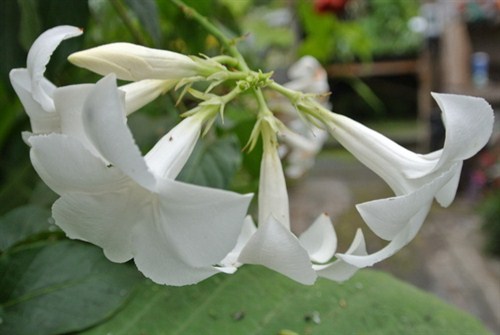Summer at last after an absence of 7 years!!
Saturday, July 27, 2013
My cup runneth over and my sap is bubbling as July 2013 brings a
month to remember. OK so there was watering to do everywhere every
day, but the joy of being able to wear shorts continuously for over
3 weeks and to eat all meals outside in a climate more like Italy
was worth all the extra work. And the pleasure of regular dips in
Moira's really warm swimming pool (temperature 27C without
artificial heating!!)
In our busiest month for visitors, it was great to be able
to welcome them with no worrries about rain or wind and for them to
see the gardens at their best. The lawns are lush green, the
herbaceous borders overflowing and the vegetables are more than
making up for the disappointments of last year, apart from a few
concerns about the runner beans not setting yet.
The lush Paddock Garden borders and lawn. On the right
is the welcome notice we post for every group visit to the gardens.
They are much photographed!
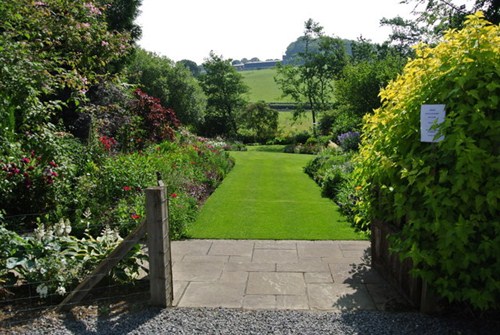 .
.
After many months this year when it was difficult to find much
to tell you about, this month there is so much I don't think I can
do it justice! Well here goes..........
Weather
26 days of daytime temperatures well in excess of the magical
21C, Max 30C on 18th and lowest night time temperature 10C on 12
th. Some rain in first few days and towards the end and although we
could now do with some substantial rain I can do without it for a
little while longer!
Garden update
Vegatables are cropping really well with cabbage,
cauliflower,broccoli, carrots, beetroot. potatoes, broad beans,
some huge cos lettuce (Lobjoits green) and lots of varied salad
leaves. Peas, courgettes and tomatoes almost ready. Carrots grown
in new beds and treated with Westland Plant Rescue for carrot fly
are vigorous and show no signs of fly, even though they have had no
fleece protection this year. Clubroot in brassicas has been a
scourge for the last 5 years but plants this year are barely
affected by it. I limed the beds very heavily in autumn and top
dressed the beds in spring with Calcified Seaweed which is an
organic soil conditioner and pelleted chicken manure. The only
failure has been with parsnips again (how many times do I hear this
when I give talks to clubs) but a second and very late sowing is
now growing away well. Celery and celeriac were slow to start with
from plants raised under heat in February but with the warm weather
and plenty of irrigation are starting to catch up.
Soft fruit has been exceptional but the berries are rather small
because of the dry weather and the fact that many of the plants
need replacing, but the blueberries are looking the best ever if
the squirrels leave them alone. Some of my raspberry canes are 20
years old and they and the soil need to be replaced. A job
for late autumn before the frosts come.
Sweet peas in the vegetable garden are prolific and need picking
or dead heading every day so that they don't stop flowering. The
scent is overpowering on warm nights and the colour range some of
the best we have had, especially a lovely reddish pink called
"Raspberry Ripple"
All the many mixed borders which have reached maturity,
having been planted for over 10 years, are putting on a great
show with so many stars it is impossible to name them all. All the
border stalwarts like delphinums, lupins, campanulas in variety,
hardy geraniums, foxgloves (some great perennial forms including
lutea, grandiflora, lantana and ferruguinea), pondside plants
especially candelabra primulas, iris, and latterly astilbes, and
the sun loving thorughbreds like dark leaved sedums, heleniums and
monardas, are doing fabulously well and because of the hot still
weather need little staking. (Phew what a sentence!) . We still
have some stragglers because of the late spring, namely impatiens
tinctoria, dahlias, cautleya spicata and the rather bizarre sight
of aquilegias still flowering at the same time as some of the
half hardys, like salvias elsewhere in the gardens. There are just
a couple of downsides: the flowers are going over more quickly than
usual and the deeper colours especially the reds are fading to pink
or orange in the bright, strong sunlight so that the Red Border is
not living up to its name, but as a hot border it still looks
great!!
Looking up the Paddock garden to the house showing the
red (hot) border and part of the pastels border.
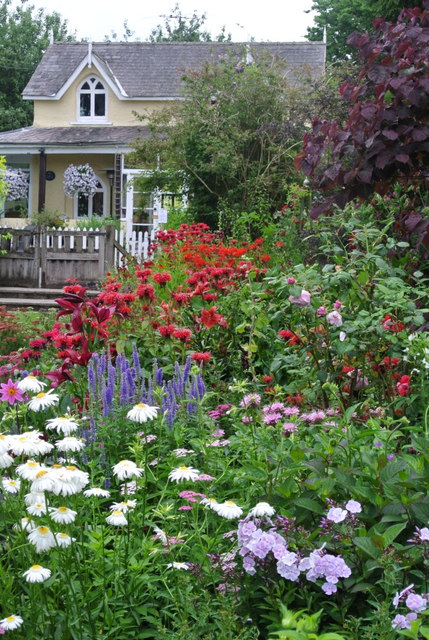
One of the red border stalwarts (slightly faded in the
sun) is monarda "Garden View Scarlet" 4 foot tall, upright and
mildew free - a real "good doer"
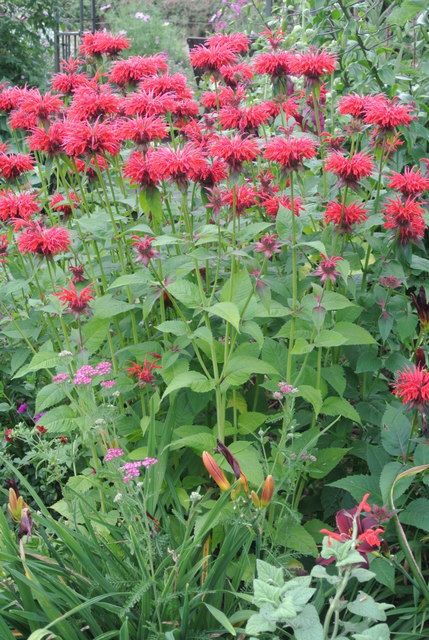
I promise this is the last time for a while that I will mention
the lawns, but it is not just me saying it, many of our visitors
have been very complimentary about them too. I can't believe they
are the same lawns that looked so dire in March. More top dressing
in August should keep them going strongly into winter.
Capsid bug continues to be a major pest, making lace
patterns of leaves on brugmansias, fuchsias, dahlias and hydrangeas
in particular. I was also concerned last month at the high
proportion of hemerocallis flower buds that were infected by the
dreaded gall midge, but as the season has progressed the later
flowering forms seem less affected and I diligently remove all the
infected buds every day (yet another daily task you will observe -
it is a wonder I ever find the time to go to bed!!)
On the subject of hems. (hemerocallis) the seedlings from 2010
American Hemerocallis Society (AHS) seed are now flowering and the
range of colour, shape and form is delightful. No real stars but
some good strong plants to 4 feet and a thrill for me and the
mostly amateur American hybridisers who created them. As they were
a gift from the AHS they are doubly welcome and I am most grateful
to all the donors and hope some of them may be readers of this
website.
In part shade and moisture retentive soil this large
stand of hems is impressive and midge free with alstroemeria
"Selina" and ligularia "The Rocket" for company. Dead heading every
day is essential tp prolong flowering
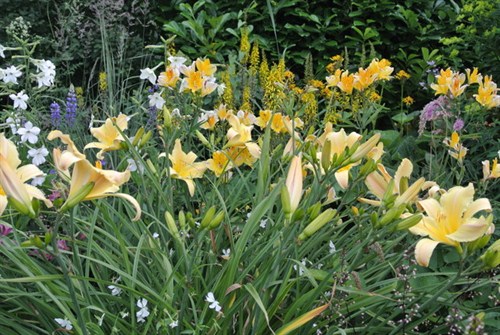
In the contrasting Red Border this tall hem is "Scarlet
Oak" in its second decade in the garden. Split 2 years ago it is
now flowering vigorously again with the fabulous almost black hem
"American Revolution ". Note the superb asiaitic lily "Black
Pearl" on the right.

What's looking good?
You could be forgiven for thinking that I have already covered
this heading above but no, there is lots more to come!!As a change
for a moment from the sheer colourful exuberance of the main
borders, there is a narrow strip under a yard wide and 20 yards
long in the House Garden adjoining the open parkland which
every year I carefully plant up as a mini "wildflower" meadow
comprising a range of smaller cultivated grasses, umbellifers both
annual and perennial, poppies and cornflowers from plug grown
seeds, and anything else that nature provides ( usually in the
right place!) It has looked really good for 6 weeks already and
there is plenty of vigour left for another month or so until it
fades away to an almost bare patch of ground again by early
autumn.
The relaxed planting on the walk to the Monet seat in
the House Garden. The mini "wildflower" meadow is on the left.
Annual plants have a vital role to play in the summer garden with
their exuberance and natural form and habit.
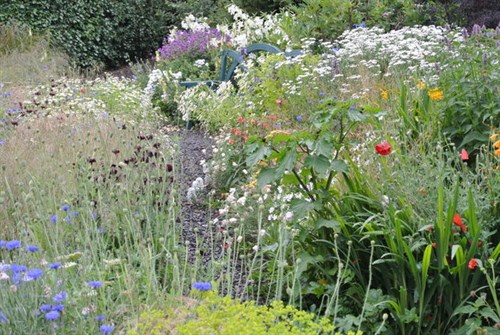
Another stunning hardy annual is this superb somniferum
poppy "Black Peony" which I use in the borders as a spectacular dot
plant in several of the borders. It is a role at nearly 4 feet that
it fulfills with distinction and it seeds around gently
too!
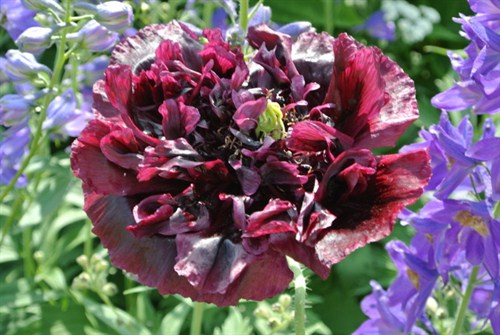
As far as individual plants are concerned the absolute star and
my biggest thrill has been the first flowering of my 6 year old
erythrina crista -galli in a pot in the large polytunnel. It is a
long time to wait but real gardeners know that unlike the quick fix
gardening one sees on TV programmes what gives the greatest
pleasure are those things we have to wait for and believe me
this one is well worth it.
The large deep red flowers of the erythrina which
twist and curl and darken as the age.

Dieramas increase in number every year and there is a great show
again in the sharply drained soil of the Koi Pond Border in the
Paddock Garden. Grow them in pots and they sulk and rarely flower
but get them into the ground or let them seed around and they
flower and multiply vigorously. They do cross readily so don't
always come true but who cares? Their arching wands to 4 feet are
one of the highlights of the July garden. Interestingly several of
our recent German visitors commented that they don't do at
all well there and are rarely for sale. The temptation was too much
for some and they succumbed to mine in the nursery! Hope they do
well for them but winter drainage in my experience is the key to
their survival.
I have rarely taken a picture that does them justice and
you must wonder what the fuss is all about. Dieramas are so airy
and ethereal that they seem to reflect light making it difficult to
capture their unforgettable impact.
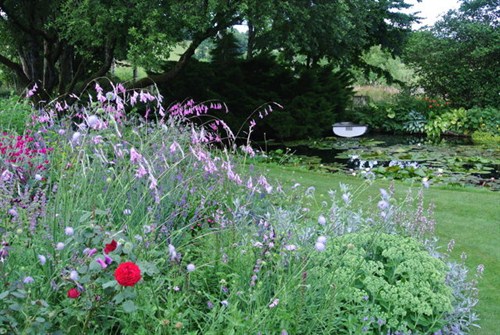
Hostas now in full flower (yes I let them flower) are still
fantastic and mollusc free, although one or two of them have burnt
a little in the strong sunshine. I make sure they get plenty of
water as this reduces the amount of scorching. Those around the
Paddock Pond are in sunshine for over half a day and never burn
because they are constantly moist.
A picture taken in shade of some smaller hostas in a
rock garden adjacent to the conservatory. The largest lime green
one in the foreground is "Lakeside Ninita" which has doubled in
size this year as have many hostas in the gardens

I have planted nicotiana alata, an annual, all over the gardens
as I raised so many from seed. With one exception they are
all white. They are a fine much branching plant with wonderful
scented flowers in the evening which in the heat have reached
almost 5 feet. Nice as they are half should have been green!
Annuals like these are treasures for filling gaps left by earlier
flowering perennials and with cosmos and rudbeckia to follow on
keep the flower power going until the frosts but they need regular
dead heading. They are so easy from seed and I couldn't be without
them.

Finally a word on behalf of campanulas a large and
perhaps underated group of plants from a couple of inches to over 7
feet that grow in a wide variety of habitats, This one is called
"Sarastro" and prefers a little shade in moister but not
waterlogged soil. Huge purple bells to about 3 inches.
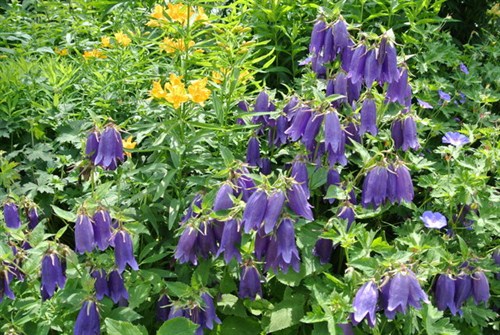
Wildlife and countryside
There has been manic activity the last few weeks with all
local farmers getting in the grass harvest, mostly in the form of
roiund bale silage the whole process taking only a day. When I
fisrt came here nearly 40 years ago the vast majority of the
harvesting was as small bale hay which talkes 4 times as long. It
was a pleasure recently to see some small bales again being
made in the field nearest to us, thanks to the fine settled
weather. Farmers do like the portability and convenience of small
bales in the depths of winter.
The view of the Lodge field from one of the bedroom
windows.

Dragonflies are much in evidence although in a limited range of
species, their used larval cases floating forlornly on the Paddock
Pond where they will have spent up to 4 years of their lives. Also
on the wing and not so welcome are legions of wasps with 3 nests at
various points of the house and outbuldings. We have also had a few
hornets in the conservatory, 3 times the size of a wasp and if you
are unlucky, a sting to match their size!!
Not many butterflies yet apart from cabbage whites and small
tortoishells, although there are myriads of moths in a staggering
range of species on the humid nights attracted by the halogen
lights. I have seen a day time flying privet hawk moth but so far
none of the hoped for hummimg bird hawk moths which I last saw here
in the hot summer of 2006. They are usually migrants form the near
continent if you are lucky enough to see one.
All the fields are quite brown already, there are few
wildflowers and the birds are generally silent in their dowdy post
breeding period.
Most of the frogs and toad tadpoles have left the pond and can
already be found all over the garden. It must seem like a marathon
to them!
Visits and visitors
Our best month for visitors with over 250 people coming to see
the gardens either as groups or private individuals. Three from
Holland, two from Germany, one from Dorset Group, Hardy Plant
Society and numerous local clubs. We are so glad that the fine
weather made for enjoyable visits and we are very grateful for all
the complimentary comments, cards and e-mails we have received.
Hardy planters can be sure to raid the nursery and
appreciate rare plants at bargain prices - not hard to please
then!!

And a group picture of our first visit from
Germany
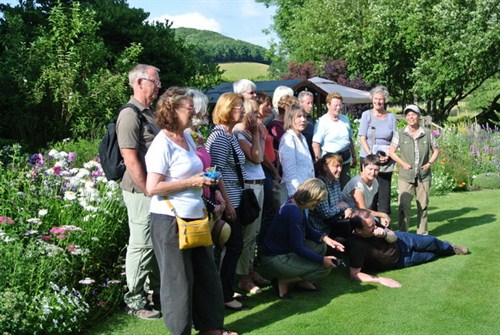
Some visitors come in more style than others and we were
amazed when a long time acquaintance Paul arrived with his wife
Jane in this Maseratti Spider !! He wasn't prepared to accept
Moira's kind offer of a swap with her Peugeot 307cc
convertlble!!
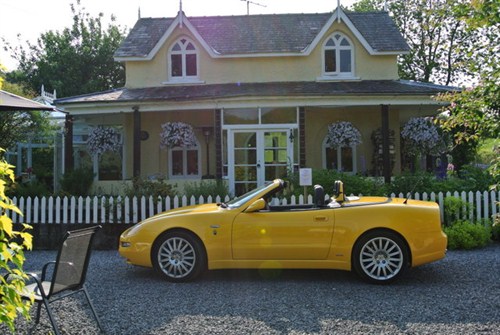
For a change we sold our plants at the recent Myddfai
Craft and Summer Festival - a lovely event in our nearest village
deep in the Carmarthenshire hills.

Royal invitation to Llwynywermod
We have had no time for any visits ourselves save for one very
special local one. At the beginning of July we were invited for an
evening reception to Llwynywermod, the Welsh home of the Prince of
Wales and Duchess of Cornwall just 2 miles from us. There was a
very generous finger buffet and copious amounts of champagne and
Duchy of Cornwall ale. It was a very pleasant evening
attended by local people and we spoke to both the Prince and
Duchess for quite some time. They expressed an interest in the
gardens here and the Prince took away one of our brochures. He
spoke animatedly about his passion for his Jubilee Meadows
intiative and what he is doing at his Welsh home and at Highgrove
to increase the number of wild flowers there, especially native
orchids which have increased substantially in number and species
over the last few years.
Daily Mail
There was one last special moment in a memorable and enjoyable
month when the Gardens Editor of the Mail contacted us. She told us
that the newspaper has recently launched a new App for its
electronic version called Mail Plus, a subscription service, and on
Saturdays there is an extra feature in the gardening section where
a 360 degree photo of a garden is shown. She asked if they
could show our garden and of course we said yes. A photographer
duly arrived all the way from Derbyshire to take the pictures which
are like nothing we have seen before but you need a tablet or i pad
to view them. The pics were due to be published on 28 July. Having
been a finalist in the Mail's 2010 National Garden Competition it
was nice to remembered and to be one of the first gatrdens to be
featured on their new App. If you don't slready subscribe there is
a free 30 day trial available in all app stores or via the
Mails' website at www.dailymailplus.co.uk/trial It
seems a very fitting way to end the month.
I leave you with this beautiful highly scented flower of
mandevilla laxa (formerly suaveolens) in the large tunnel. The next
leap forward in digital technology is to devise a means of
conveying scent !!
